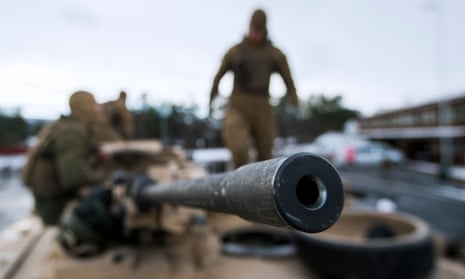The US has announced it is sending depleted uranium anti-tank rounds to Ukraine, following Britain’s lead in sending the controversial munitions to help Kyiv push through Russian lines in its gruelling counteroffensive.
The 120mm rounds will be used to arm the 31 M1A1 Abrams tanks the US plans to deliver to Ukraine in the coming months.
The armour-piercing rounds were developed by the US during the cold war to destroy Soviet tanks, including the same T-72 tanks that Ukraine faces in its counteroffensive.
What is depleted uranium?
Depleted uranium is a byproduct of the process to create the rarer, enriched uranium used in nuclear fuel and weapons. Although less radioactive than enriched uranium and ordinarily incapable of generating a nuclear reaction, depleted uranium is extremely dense – more dense than lead – a quality that makes it highly attractive as a projectile.
“It’s so dense and it’s got so much momentum that it just keeps going through the armour – and it heats it up so much that it catches on fire,” says Edward Geist, a nuclear expert and policy researcher at the US-based Rand non-profit research institution.
When fired, a depleted uranium munition becomes “essentially an exotic metal dart fired at an extraordinarily high speed,” Rand senior defence analyst Scott Boston added.
This means that when it strikes a tank’s armour, it cuts through in the blink of an eye before igniting after contact, creating soaring temperatures that will explode the tank’s fuel and ammunition.
Do depleted uranium munitions pose a health risk?
While depleted uranium munitions are not considered nuclear weapons, their emission of low levels of radiation has led the UN nuclear watchdog to urge caution when handling and warn of the possible dangers of exposure.
The handling of such ammunition “should be kept to a minimum and protective apparel (gloves) should be worn”, the International Atomic Energy Agency cautions, adding that “a public information campaign may be required to ensure that people avoid handling the projectiles”.
“This should form part of any risk assessment and such precautions should depend on the scope and number of ammunitions used in an area.”
The IAEA notes that depleted uranium is mainly a toxic chemical, as opposed to a radiation hazard. Particles in aerosols can be inhaled or ingested, and while most would be excreted again, some can enter the blood stream and may cause kidney damage.
“High concentrations in the kidney can cause damage and, in extreme cases, renal failure,” the IAEA says.
Depleted uranium munitions, as well as depleted uranium-enhanced armour, were used by US tanks in the 1991 Gulf war against Iraq’s T-72 tanks and again in the invasion of Iraq in 2003, as well as in Serbia and in Kosovo.
A recent review of studies in BMJ Global Health highlighted “possible associations” of long-term health problems among Iraqis linked to depleted uranium use on the battlefield.
An analysis from the World Health Organization concluded that “in some instances the levels of contamination in food and groundwater could rise after some years” and should be monitored, and recommends clean-up actions be taken where “depleted uranium contamination levels are deemed unacceptable by qualified experts”.
How has Russia reacted to the US announcement?
The Russian embassy in Washington denounced the decision as “an indicator of inhumanity”, adding that “the United States is deluding itself by refusing to accept the failure of the Ukrainian military’s so-called counteroffensive.”
In a social media post on Telegram, Russian foreign ministry spokesperson Maria Zakharova also slammed the US decision, writing: “What is this: a lie or stupidity?” She claimed an increase in cancer had been noted in places where ammunition with depleted uranium was used.
In March, when Britain said it would supply the shells, the Russian president, Vladimir Putin, warned that Moscow would “respond accordingly” given that the west was starting to use weapons with what he called a “nuclear component”.
Putin followed up several days later by saying Russia would respond by stationing tactical nuclear weapons in neighbouring Belarus. Putin and the Belarusian president said in July that Russia had already shipped some of the weapons.
This article was amended on 18 September 2023 to clarify that a depleted uranium munition does not explode itself, but rather ignites after contact which can cause an explosion.
Associated Press and Reuters contributed to this report
